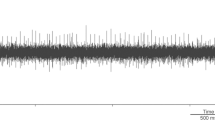Abstract
We describe a case of acute generalized dystonia due to bilateral damage to the basal ganglia, mainly affecting the globi pallidi. The lesion was probably related to a hypoxic condition following a heroin injection. Therapy with pimozide almost completely controlled the dystonia.
Sommario
Descriviamo un caso di distonia acuta generalizzata conseguente a un danno bilaterale dei gangli della base interessante principalmente i nuclei pallidi. Verosimilmente la lesione era causata da uno stato ipossico secondario a iniezione di eroina. La terapia con pimozide è stata efficace nel controllare la distonia.
Similar content being viewed by others
References
Bhatt M.H., Obeso J.A., Marsden C.D.:Time course of postanoxic akinetic-rigid and dystonic syndromes. Neurology 43: 314–317, 1993.
Burke R.E., Fahn S., Gold A.P.:Delayed-onset dystonia in patients with “static” encephalopathy. J. Neurol. Neurosurg. Psychiatry 43: 789–797, 1980.
Jellinger K.,Exogenous lesions of the pallidum. In: Vinken P.J., Bruyn G.W. and Klawans H.L. (Eds.), Handbook of Clinical Neurology. Vol. 5 (49). Elsevier Science Publishers, Amsterdam, pp. 465–491, 1986.
Jellinger K.:(Exogenous) striatal necrosis. In: Vinken P.J., Bruyn G.W. and Klawans H.L. (Eds.), Handbook of Clinical Neurology. Vol. 5 (49). Elsevier Science Publishers, Amsterdam, pp. 499–518, 1986.
Keane J.R., Young J.A.:Blepharospasm with bilateral basal ganglia infarction. Arch. Neurol. 42: 1206–1208, 1985.
Laplane D., Levasseur M., Pillon B. et al.:Obsessive-compulsive and other behavioural changes with bilateral basal ganglia lesions. Brain, 112: 699–725, 1989.
Marsden C.D., Obeso J.A., Zarranz J.J., Lang A.E.:The anatomical basis of symptomatic hemidystonia. Brain 108: 463–483, 1985.
Pettigrew L.C., Jankovic J.:Hemidystonia: a report of 22 patients and a review of the literature. J. Neurol. Neurosurg. Psychiatry 48: 650–657, 1985.
Pulst S.M., Walshe T.M., Romero J.A.:Carbon monoxide poisoning with features of Gilles de la Tourette's syndrome. Arch. Neurol. 40: 443–444, 1983.
Schwartz A., Hennerici M., Wegener O.H.:Delayed choreo-athetosis following acute carbon monoxide poisoning. Neurology 35: 98–99, 1985.
Author information
Authors and Affiliations
Additional information
Deceased
Rights and permissions
About this article
Cite this article
Benassi, G., Rinaldi, R., Azzimondi, G. et al. Acute generalized dystonia due to a bilateral lesion of basal ganglia mainly affecting the nuclei pallidi. Ital J Neuro Sci 17, 71–73 (1996). https://doi.org/10.1007/BF01995712
Received:
Accepted:
Issue Date:
DOI: https://doi.org/10.1007/BF01995712




